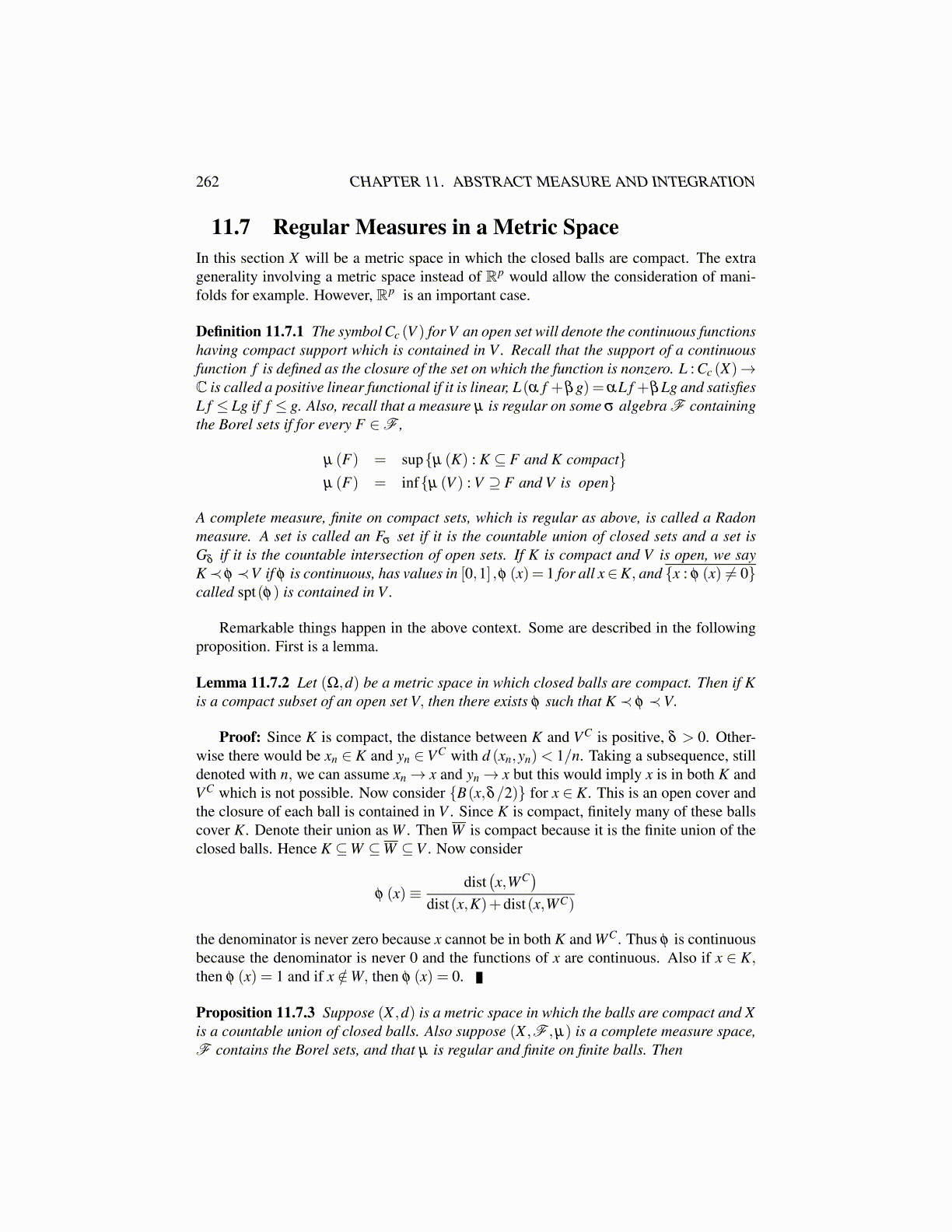
262 CHAPTER 11. ABSTRACT MEASURE AND INTEGRATION
11.7 Regular Measures in a Metric SpaceIn this section X will be a metric space in which the closed balls are compact. The extragenerality involving a metric space instead of Rp would allow the consideration of mani-folds for example. However, Rp is an important case.
Definition 11.7.1 The symbol Cc (V ) for V an open set will denote the continuous functionshaving compact support which is contained in V . Recall that the support of a continuousfunction f is defined as the closure of the set on which the function is nonzero. L : Cc (X)→C is called a positive linear functional if it is linear, L(α f +βg) =αL f +βLg and satisfiesL f ≤ Lg if f ≤ g. Also, recall that a measure µ is regular on some σ algebra F containingthe Borel sets if for every F ∈F ,
µ (F) = sup{µ (K) : K ⊆ F and K compact}µ (F) = inf{µ (V ) : V ⊇ F and V is open}
A complete measure, finite on compact sets, which is regular as above, is called a Radonmeasure. A set is called an Fσ set if it is the countable union of closed sets and a set isGδ if it is the countable intersection of open sets. If K is compact and V is open, we sayK≺ φ ≺V if φ is continuous, has values in [0,1] ,φ (x)= 1 for all x∈K, and {x : φ (x) ̸= 0}called spt(φ) is contained in V .
Remarkable things happen in the above context. Some are described in the followingproposition. First is a lemma.
Lemma 11.7.2 Let (Ω,d) be a metric space in which closed balls are compact. Then if Kis a compact subset of an open set V, then there exists φ such that K ≺ φ ≺V.
Proof: Since K is compact, the distance between K and VC is positive, δ > 0. Other-wise there would be xn ∈ K and yn ∈VC with d (xn,yn)< 1/n. Taking a subsequence, stilldenoted with n, we can assume xn→ x and yn→ x but this would imply x is in both K andVC which is not possible. Now consider {B(x,δ/2)} for x ∈ K. This is an open cover andthe closure of each ball is contained in V . Since K is compact, finitely many of these ballscover K. Denote their union as W . Then W is compact because it is the finite union of theclosed balls. Hence K ⊆W ⊆W ⊆V . Now consider
φ (x)≡dist(x,WC
)dist(x,K)+dist(x,WC)
the denominator is never zero because x cannot be in both K and WC. Thus φ is continuousbecause the denominator is never 0 and the functions of x are continuous. Also if x ∈ K,then φ (x) = 1 and if x /∈W, then φ (x) = 0.
Proposition 11.7.3 Suppose (X ,d) is a metric space in which the balls are compact and Xis a countable union of closed balls. Also suppose (X ,F ,µ) is a complete measure space,F contains the Borel sets, and that µ is regular and finite on finite balls. Then